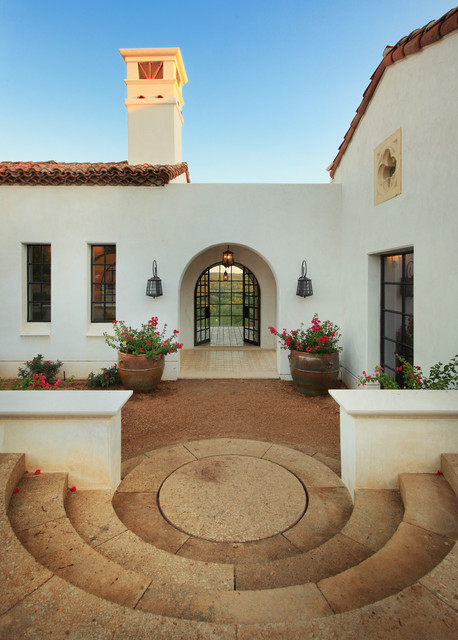
As a fan and owner of a 1927 Spanish Colonial Revival home, I can't get enough of them. Every one I have come across has been unique and well-constructed with lots of character and charm. This type of architecture was born as a result of the Panama-California Exposition, and became a U.S. style movement from 1915 to 1931. It is a hybrid style based on the architecture found during the early Spanish colonization of North and South Americas. It started in California and Florida, which had the ideal climate for Mediterranean-inspired homes, and remains popular today. In Spanish Revival architecture, new features were added to classic ones to create a distinct look. Let’s explore some of the exterior elements which define this style:
1. Curves and arches. Here, curved steps lead to a graceful archway to the front door.
2. White stucco exterior and walls. Fresh white paint covers roughly textured stucco — a hand-applied mix of cement, water and sand or lime. The result is an aged-looking Old World surface.
3. Painted tile. Here, a beautifully curved staircase reveals another classic feature: handpainted tiles on the stair risers.
4. Terracotta roof tiles. The red clay roof tops give the homes a warm, earthy, rustic look. Often the roof lines are multi-level to create interest and asymmetry. This home features a turret.
5. Tower-like chimneys. No detail is too small. This functional chimney is given special treatment with moldings and little windows.
Here is one which stands proudly with little arched windows and its own tile roof. The decorative ledges below it are perfect for displaying rustic planters.
6. Balconies. These were designed so that you could step out from your room above to enjoy the fresh air and views.
Wooden doors and gates often feature iron details. These lanterns are typical Spanish Revival.
Here are some scrolled stair railings.
8. Courtyards and patios. The mild climate of the Mediterranean encouraged outdoor living, so the Spanish created lots of spaces to enjoy outside. The patios often had fireplaces which allowed you to linger outside late into the night.
9. Arcades. A series of arches supported by columns is called an arcade. This is an old architectural feature which originated in Rome. In the Mediterranean, the arcades sheltered walkways in town squares.
Here is an inside view of another arcade. Notice the expansive terracotta tiled patio it covers, the impressive woodwork above and the outdoor fireplace. All you need is some comfy furniture and you’ll never want to leave.